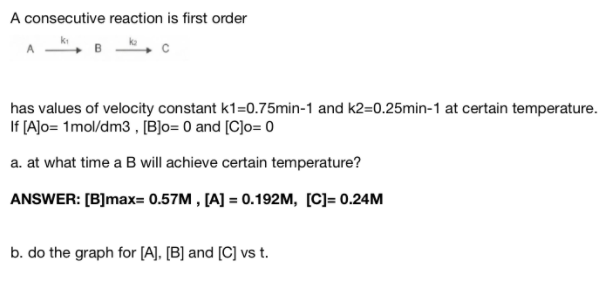Answered step by step
Verified Expert Solution
Question
1 Approved Answer
Subject: Physical Quemistry MY QUESTION: In excercise (a) there is an identity: [A]o=e^(-k1t) and [B]= ((k1[A]o)/(k2-k1))(e^(-k1t)-e^(-k2t)) which the professor took d[B]/dt=0=d/dt[ k1[A]o)/(k2-k1)(e^(-k1tmax)-e^(-k2tmax) I dont understand
Subject: Physical Quemistry

MY QUESTION: In excercise (a) there is an identity: [A]o=e^(-k1t) and [B]= ((k1[A]o)/(k2-k1))(e^(-k1t)-e^(-k2t)) which the professor took
d[B]/dt=0=d/dt[ k1[A]o)/(k2-k1)(e^(-k1tmax)-e^(-k2tmax)
I dont understand how the professor made the process to get from that to the equation
tmax=((1)/(k1-k2))ln(k1/k2)
If someone could enlighten me by providing me with both parts of the same excercise I will apreciate because I dont know how to proceed to do the graph in part (b)
A consecutive reaction is first order has values of velocity constant k1=0.75min-1 and k2=0.25min-1 at certain temperature. If [A]o= 1mol/dm3 , [B]o= 0 and [C]o= 0 a. at what time a B will achieve certain temperature? ANSWER: [B]max= 0.57M , [A] = 0.192M, [C]= 0.24M b. do the graph for [A], [B] and [C] vs tStep by Step Solution
There are 3 Steps involved in it
Step: 1

Get Instant Access to Expert-Tailored Solutions
See step-by-step solutions with expert insights and AI powered tools for academic success
Step: 2

Step: 3

Ace Your Homework with AI
Get the answers you need in no time with our AI-driven, step-by-step assistance
Get Started


